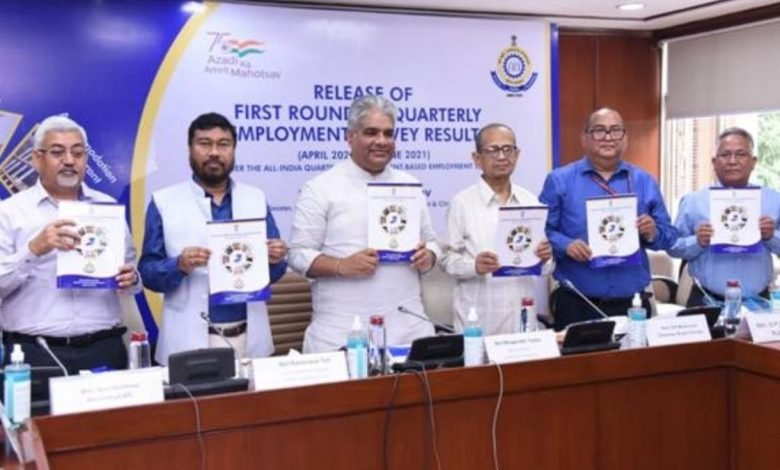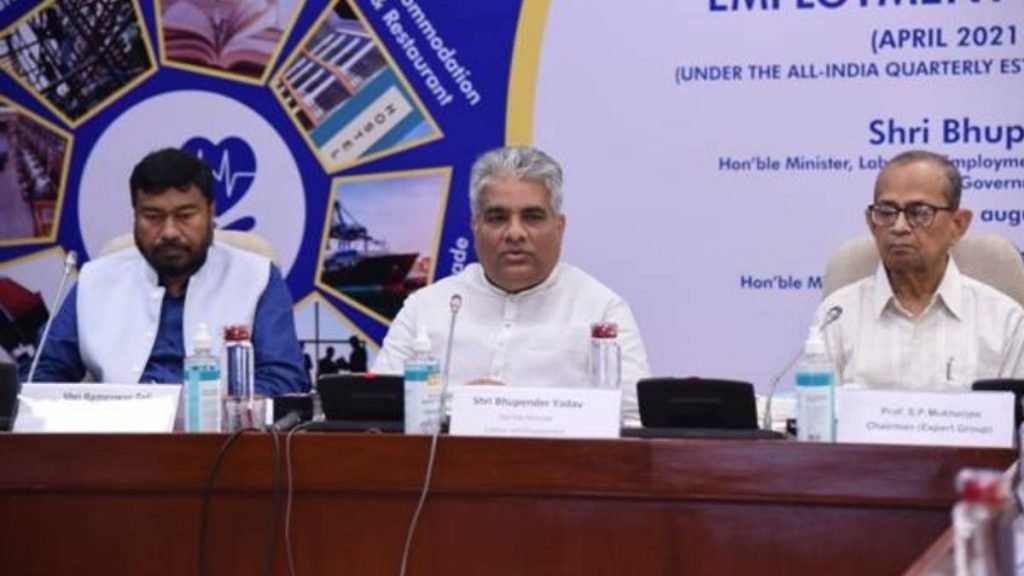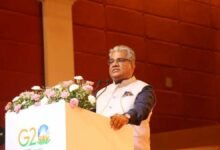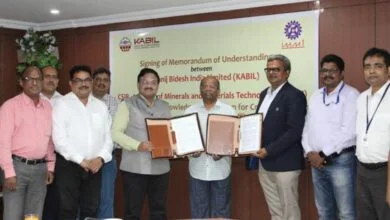Shri Bhupender Yadav releases the report of Quarterly Employment Survey (QES) employing 10 plus workers

Estimated total employment in the nine selected sectors from the first round of QES is 3 crores and 8 lakhs, a growth rate of 29% over 2013-14
Labour and Employment Minister Shri Bhupender Yadav today released the report of the first quarter of the Quarterly Employment Survey (QES) part (April to June 2021), of the All-India Quarterly Establishment-based Employment Survey (AQEES) prepared by the Labour Bureau.
The AQEES has been taken up by the Labour Bureau to provide frequent (quarterly) updates about the employment and related variables of establishments, in both organized and unorganized segments of nine selected sectors. These sectors altogether account for a majority of the total employment in the non-farm establishments. These nine selected sectors are Manufacturing, Construction, Trade, Transport, Education, Health, Accommodation and Restaurant, IT/ BPO, and Financial Services.
The event was graced by the presence of Shri Rameswar Teli, Minister of State (L&E), Shri Sunil Barthwal, Secretary L&E, Shri D.P.S. Negi, Principal Labour & Employment Advisor, and Shri I.S. Negi, Director General, Labour Bureau. Chairman, Expert Group on All India Surveys, Prof. S.P. Mukherjee was also present.
Announcing the results, Shri Bhupender Yadav said, the estimated total employment in the nine selected sectors from the first round of QES is 3 crores and 8 lakhs approximately against a total of 2 crores and 37 lakhs in these sectors taken collectively, as reported in the Sixth Economic Census (2013-14) reflecting a growth rate of 29 percent.
QES henceforth will provide frequent (quarterly) updates about the employment and related variables of establishments, in both organized and unorganized segments of nine selected non-farm sectors.
“Of the total employment estimated in the selected nine sectors, Manufacturing accounts for nearly 41 percent followed by Education with 22 percent, and Health 8 percent. Trade as well as and IT/BPO each engaged 7 percent of the total estimated number of workers.”, further informed the Union Minister.

Shri Bhupender Yadav mentioned that data on all aspects of labor is crucial. “Evidence-based policymaking and statistics based execution is the major focus of Prime Minister Shri Narendra Modi” emphasized the Labour Minister saying that such scientifically collected data with purity and integrity that can be cross-examined will be immensely beneficial towards achieving targeted and last-mile delivery of government programs and schemes.
Sharing the findings on the pandemic induced employment retrenchment/ decline, the Labour Minister informed that it was found that the impact was evident in 27 percent of the establishments however the silver lining was that 81 percent of the workers received full wages during the lock-down period (March 25–June 30, 2020).
Key Highlights of the first round of Quarterly Employment Survey
• The most impressive growth of 152 percent has been recorded in the IT/BPO sector, while growth rates in Health are 77 percent, in Education, it is 39 percent, in Manufacturing it is 22 percent, in Transport it is 68 percent and in Construction, it is 42 percent. However, employment in Trade came down by 25 percent and in Accommodation & Restaurant, the decline was by 13 percent. Financial services saw a growth rate in employment of 48 percent.
• Nearly 90 percent of the establishments have been estimated to work with less than 100 workers, the corresponding figure during EC 6 is 95 percent. Nearly 35 percent of the IT/ BPO establishments worked with at least 100 workers, including about 13.8 percent engaging 500 workers or more. In the Health sector, 18 percent of the establishments had 100 or more workers.
Evidence-based policy making and statistics based execution is the major focus of Government: Shri Bhupender Yadav
• The overall participation of female workers stood at 29 percent, slightly lower than 31 percent reported during 6th EC.
• Regular workers constitute 88 percent of the estimated workforce in the nine selected sectors, with only 2 percent being casual workers. However, 18 percent of workers in the Construction sector are contractual employees and 13 percent are casual workers.
• Only 9 percent of the establishments (with at least 10 workers) were not registered with any authority or under any act. While 26 percent of all the establishments were registered under the Companies Act with 71 percent registration in IT/ BPO, 58 percent registration in Construction, 46 percent in Manufacturing, 42 percent in Transport, 35 percent in Trade and 28 percent in Financial Services.
• Around 18 percent of the establishments have the provision of on-job skill training programs.
There are two components under AQEES, Quarterly Employment Survey (QES) and Area Frame Establishment Survey (AFES). QES has been initiated to compile relevant data from about 12,000 establishments selected through a sampling design to represent each of the nine sectors within each state/ Union Territory, as also each size class (range of a number of workers) within each sector-State/ UT.
Area Frame Establishment Survey (AFES) covers the unorganized segment (with less than 10 workers) through a sample survey. AQEES will provide a consolidated picture with both the organized and the unorganized segments of the non-farm economy. The first round of QES had a reference date of April 1, 2021, for the different items of information about an establishment.
The results on the first round of the “Quarterly Employment Survey” April- June 2021) are very important to give insights into the concepts, definitions, and sampling design adopted for estimation of sectoral employment estimates. This will serve as useful data for policy-makers, Central/ State Governments officials, researchers, and other stakeholders.








